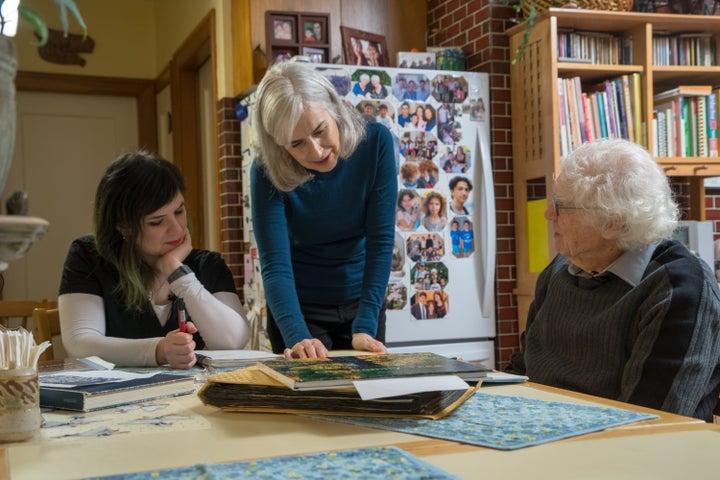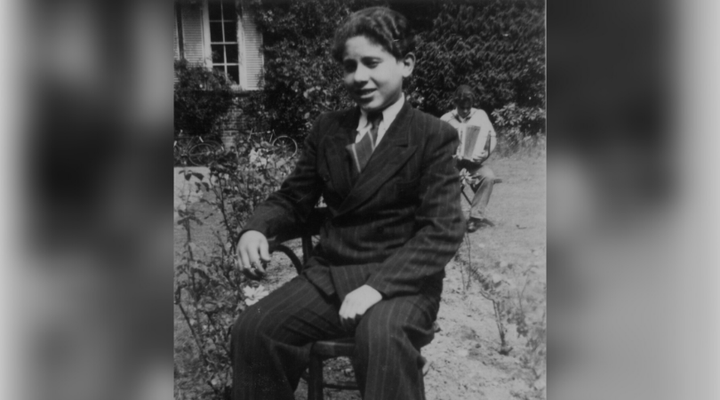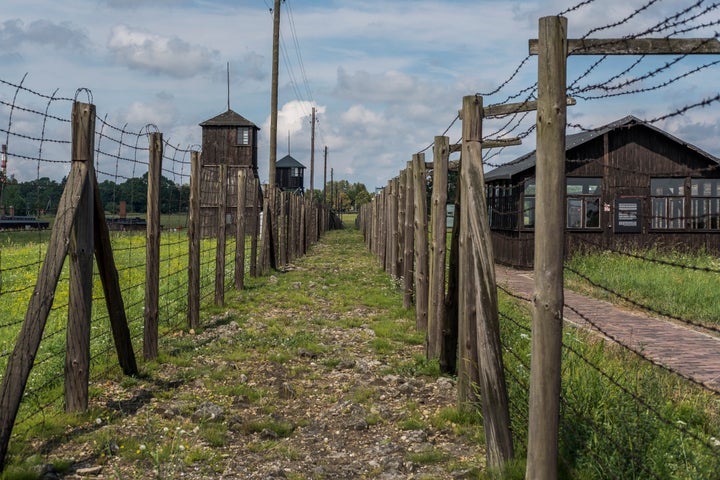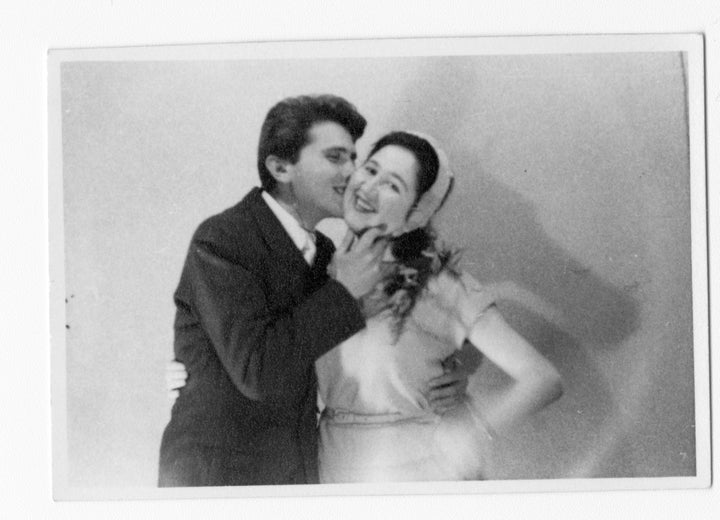
For decades, when anyone asked Pinchas Gutter about his past, he was only able to talk about his life before the Holocaust.
What it was like growing up in a large, affluent Hasidic Jewish family in Lodz, Poland; that his ancestors were winemakers for more than 400 years; how childhood was quiet for him and his twin sister Sabina, mother and father.
If Gutter revisited their murder in the gas chambers, the extermination of 95 per cent of his extended family, or the Warsaw ghetto and six concentration camps he survived, he’d shake and shiver and experience intense nightmares. He feared he’d be unable to work or look after his wife and three children.
“I decided it was bad enough I had to deal with it on my own,” Gutter told HuffPost Canada from his Toronto home. His children knew he was a Holocaust survivor, but he didn’t “bombard” them with information, he said.
It wasn’t until 50 years after he was liberated by the Soviet Army from Theresienstadt concentration camp and ghetto that he realized the importance of documenting his story and he began to share it with researchers and writers.

“I still do get nightmares,” said Gutter, 87. “But it is not at all like it was before. When you start to regurgitate what happened, it’s cathartic and liberates you.”
Monday is Holocaust Remembrance Day and the 75th anniversary of the liberation of Auschwitz — the German Nazis’ largest death camp in occupied Poland during the Second World War. Six million Jews were murdered in the Holocaust.
Survivors, now in their 80s and 90s, are sharing their stories to remind us of humans’ capacity to commit atrocities, and to help ensure it never happens again.
“I regard talking about the Holocaust not as something I want to do, but because it’s a duty to humanity, it effects humanity,” Gutter said. He points to the autrosities committed during Rwandan genocide and wars in Kosovo in the 1990s and in the Syrian conflict that began in 2011; the anti-semitisim “rearing its ugly head” and “horrific nationalism” emerging in countries around the world.
Gutter is the first survivor to be recreated as an interactive hologram as part of the University of Southern California Shoah Foundation’s New Dimensions in Testimony. The project took three years, finishing in 2016, and he had to answer 2,000 questions, but his likeness is preserved forever ready to answer the questions of future generations, Gutter said.
Throughout the 2000s, Gutter has spoken at schools to “youngsters” (his favourite audience) and teeangers, libraries and universities around the world. He’s been interviewed for documentaries and non-fiction books, and wrote a memoir Memories in Focus. He published it with help from the Toronto-based charity, Azrieli Foundation.
“Pinchas is one of the most famous survivors in the world,” said Jody Spiegel, director of the memoirs program, which since 2005 has published more than 100 survivor stories, varying from a few lines of poetry to a box of handwritten pages that are sorted and fact checked.
“The fact people survived this tragedy and have hope and created communities is inspiring. Their resilience is amazing.”
The memoirs spur conversations, and provide details integral to people understanding the true devastation of the Holocaust.
“We say six million (Jews were killed). That means nothing, numbers mean nothing,” said Spiegel. “Most Canadians don’t know the details we’re supposed to be remembering.”
For years, the Auschwitz Memorial Twitter account has been sharing the names and other details of prisoners killed at Auschwitz-Birkenau in Nazi-occupied Poland. This year, press officer Pawel Sawicki is tweeting the stories of about a dozen victims a day based on their birthdate, rather than the day they died.
“Auschwitz is a story of muder, suffering and tragic fate, but a birthday is something every human can relate to,” Sawicki told HuffPost. The account just reached one million followers.
He goes through Holocaust databases to find victim photos and any available facts about their lives, and selects from as many groups as possible, including Poles, Jews, Roma, political prisoners and people of other nationalities, young and old.
Sawicki has 1.3 million people to choose from. That’s how many were deported to Auschwitz.
The process can be subjective, he acknowledges.
“I go to (the photos of) those people and look them in the eye and its something really captivating and personal, a very subjective choice,” Sawicki said. “It’s very emotional for me.”
At the University of Victoria, a professor is also taking a novel approach to educating people about the Holocaust. Charlotte Schallie, chair of Germanic and Slavic studies, has connected survivors in Canada, the Netherlands and Israel with artists to create three graphic novels. The novels will be used in classrooms around the world and translated into several languages.
“It’s an incredibly rich and exciting medium to look at,” said Schallie. She first got the idea about four years ago when her young son, who was resistant to reading, couldn’t put down graphic novels.

The project is also personal because her grandmother was murdered in Auschwitz, an intergenerational trauma that was never discussed in her family, said Schallie.
“There’s always been so much silence around it, I feel this is me coming to terms with it,” Schallie said. “Often the story is hidden and not talked about and I think graphic novels can tell you what’s not being told.”
Holocaust survivor David Schaffer’s story will be told in one of the graphic novels.
He and his family, originally from Romania, hid in a village in the Transnistria region, on the border of modern day Moldova and Ukraine, Schaffer wrote in his memoir One Shall Not Be Tested. They lived in constant fear of being killed by soldiers in the area, and faced starvation, hiding in a small shelter with a dirt floor and straw roof alongside another family.
In that region, 90,000 Jews perished.
Through the graphic novel, Schaffer wants to reach young people.
“It is important to understand that the young people who comited the atrocities came from normal families from cities and villages and were motivated to torture and murder innocent and helpless people of all ages,” he said. “The survivor population is fading away fast and it is important that we share our difficult story of survival and struggle.”
Watch: Holocaust survivors commemorate 75 years since Auschwitz-Birkenau was liberated. Story continues below
Gutter’s life can be mapped out through the eight languages he speaks.
As a child, he spoke Polish and Yiddish at home. He and Sabina, and their mother and father fled Lodz after his father was brutally beaten by Nazis in 1939, following the invasion of Poland. They lived in the Warsaw Ghetto for two and a half years, often hiding behind false walls, in crawl spaces and attics and a makeshift bunker, anywhere to avoid deportation.
In April 1943, Gutter was 11 years old when they were rounded up by the Nazis. He can still describe the walk from the bunker to the train station as if watching a movie.
“A line of armed machine gun paratroopers marched us through the streets, close to the evening. Fire was burning on both sides,” Gutter said in a testimonial video filmed in 1995. “We walked through rivers of fire. People would break away from the column and Germans would shoot them.”
They were pushed into a “resettlement point” — an institutional building where men dressed all in black beat them with sticks, and soldiers took young women into a back room where they were sexually assaulted. His parents had snuck in a block of sugar in a sock, and would give it to the children packed in all around them, Gutter said.

Three days later, they were forced into cattle cars and transported to the death camp Majdanek. As Nazis selected victims, deciding in a split second if a person would be sent to forced labour or killed, Gutter watched Sabina run toward their mother. Her gold plait is the last and only thing he can remember about her — no photos of her survived the war.
“We grew up together. We were in our mother’s womb together. I can’t see Sabina at all. It’s just horrific,” he said.
Sabina and their mother were marched away and likely killed in the gas chamber that day, he said.
Gutter and his father were part of a crowd of men forced into a barracks by soldiers and their dogs. They striped naked and were told to run with their arms up. As prisoners approached a man dressed in a white lab coat, he’d push them left or right with a stick. Gutter lost sight of his father and never saw him again.
“I learned later in the camp we were running with our arms up, not in front, because it was easier to push more people into the gas chamber,” Gutter told HuffPost. “It was a system of murder that was worked out to a tee. Everything was calculated.”

From that moment on, Gutter said he was in a state of “suspended animation,” living second to second. “There was no yesterday, no tomorrow. It was this very minute because anybody could hit you, shoot you, kill you.”
Gutter learned German, as he was sent to a succession of camps and laboured as a slave in ammunition, bazooka and iron factories. He was forced on a death march for weeks to the Theresienstadt camp and ghetto.
“We drink water from ditches. We ate leaves, anything crawling, raw corn, wheat, anything we could chew,” Gutter said. Of the 1,500 who started marching in April 1945, only 750 made it to the camp. On May 8, it was liberated by the Soviet army.
Months later, the Allied troops flew Gutter to England on a Lancaster bomber where he stayed in an orphanage. He also lived in France, served in the Israeli army, and worked in Brazil, mastering English, French, Hebrew and Portugese. He and his wife, Dorothy, raised their children in South Africa where he picked up Afrikkans. In 1985, they immigrated to Toronto.

He and Dorothy have been married for more than 60 years. They’ve tackled his past together, understanding he was shaped by the Holocaust.
“Emotions are difficult to talk about because don’t forget my schooling,” Gutter said. “From the ages of eight to 13, the five years of the war, my schooling was horror, death and terror. I learned that when my father went out, he might be caught. He might be shot. We were always waiting.
“I love my wife. I love my family. But how does love manifest itself? Fear all the time. I am always worried about them.”